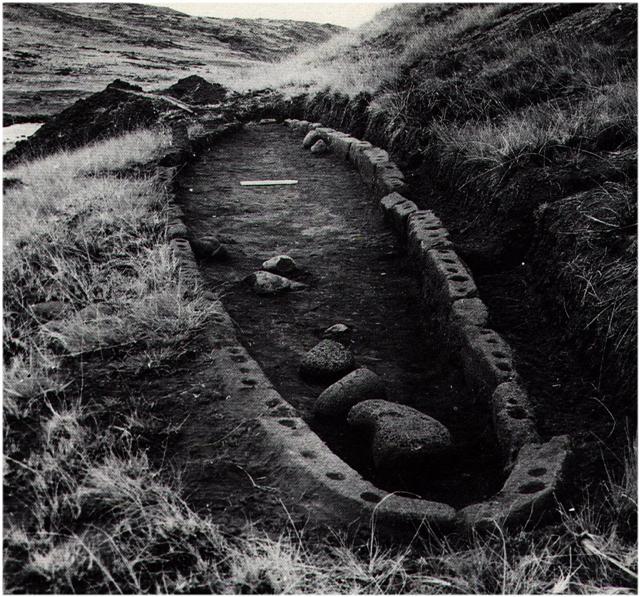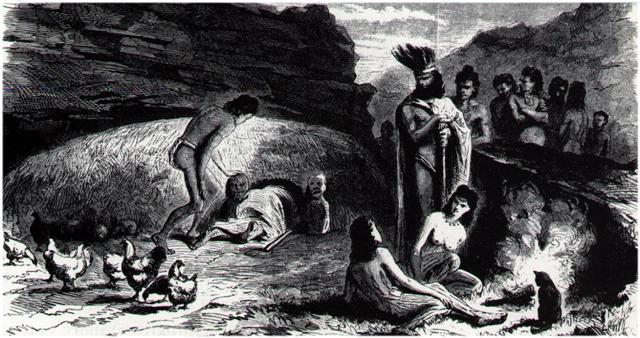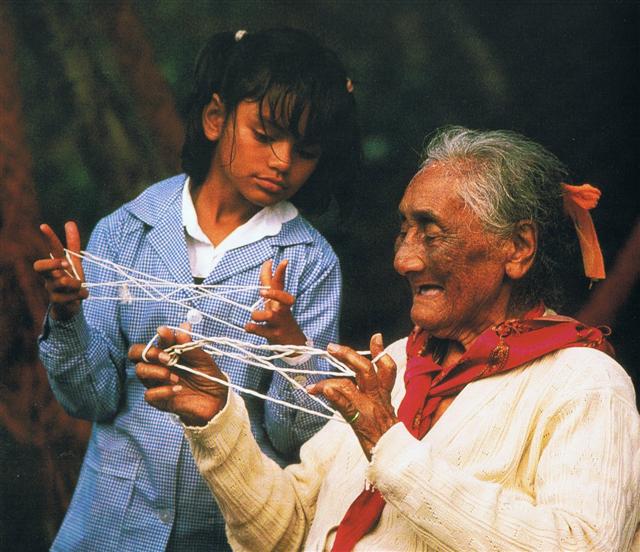|
584
70 My grandmother was helpful. For instance had she sometimes referred to the distant (wa, cfr Maia-wa) Tahiti - Hottaheiti. ... The Gilbert Islanders are Polynesians, having emigrated, according to their traditions, from Upolu, Samoa, which they look upon as te buto (Maori pito), the Navel of the World. They never counted the nights of the Moon beyond the twentieth, so far as Grimble was able to ascertain, and in the vagueness of their lunar calendar bore no resemblance to their Micronesian neighbors of the Carolines ... One of the names for east, Makai-oa, was said to be the name of a far eastern land, not an island, which their navigators had visited in ancient times. Tradition called this great land 'the containing wall of the sea, beyond the eastern horizon, a continous land spreading over north, south, and middle, having a marvelous store of all sorts of food, high mountains and rivers'. It was also called Maia-wa (wa being 'space, distant'). This is a clear reference to ancient voyages to the American coast from which the Polynesians are thought to have introduced the sweet potato into the Pacific area. The similarity of Maia to Maya may be more than a coincidence ... ... The cosmic background on Easter Island was not the same as that north of the equator and therefore we should expect a perceptional contrast based on for instance 24 + 8 = 32 on one hand and 26 - 8 = 18 = 50 - 32 on the other, for this could be perceived in the overturned boat (kava) of the Gilbertese ...: ... It is certainly true that the exterior form of the hare paenga, when the superstructure and thatch are intact, resembles an overturned boat, with the form established by the foundation. However, it is equally true (and perhaps equally important) that the configuration of the foundation is otherwise most like the Rapa Nui vulva design called komari. The komari is the quintessential female symbol which is everywhere prominent in Rapa Nui art, often carved in rock and wood, incised on human crania, and painted on the human body. In the hare paenga foundation form, the komari is cut in stone and embedded in the earth, the cosmologically female realm.
Spanning above, over and virtually into this komari foundation is the ridgepole 'backbone' and curved rafter 'ribs' of what I surmise to be a symbolically male form. In short, we have a shelter which may be metaphorically understood as 'the sky father enclosing his progeny as he embraces the earth'. Those progeny entered and departed this male/female, earth/sky form through a low, dark tunnel which may be logically compared to the birth canal. This postulated symbolism does not, of course, negate the 'overturned boat' comparison, since Polynesian canoes were often likened to the bodies of great ancestors or to Tane as First Man. The canoe which transported the first exploratory voyage to Rapa Nui was said to have been called The Living Wood, a reference to Tane. Indeed, it is likely that the 'overturned boat' concept and its relationship to home, hearth and lineage, which is so graphically visible, was commonly understood (hence its retention in the oral literature), while the more esoteric godly connections, perhaps along the lines of those explored here, were known only by spiritual leaders ...
She also always gave me the Swedish version of Reader's Digest for the coming year as a Christmas gift. This enlarged my world view considerably. And she introduced me to playing with cards. By the way, one of her sisters had the gift of using such cards in order to predict the future - not a gift however, but rather a burden for sometímes she saw things which she refused to tell about. My mother had 3 sisters and a brother. She was the eldest and was given the unusual name Tyra. Then came her younger sister Tora, also a peculiar name. But at that time these names did not reveal much to me, they were just arbitrary labels. Now, on the other hand, I can see what my grand mother may have meant. Because Tyra and Tora should be the female versions of Tyr (Mars) and Tor (Jupiter). The added end vowel 'a' evidently carries the idea of 'female'.
In a way Tyra and Tora together covered the first half of the Sun year. Then followed 3 more normal names:
The great old family photo hanging on my bedroom wall possibly reveals further signs of her wor(l)d order, ... Keep the word. So be it, said the head of One and Seven Hunaphu - they were of one mind when they did it ...
viz. a withershins movement from top right at the sitting figure of Arvid, my granfather, to my standing grandmother Magda at top left by way of Tyra and Tora, and then downwards to Ingrid, past Bernt (5 letters) and ending at Berit (5 letters), the youngest of them, sitting in her father's lap:
5 + 4 + 4 + 5 = 18(0) → 360 / 2 6 + 5 + 5 = 16(0) → *320 / 2 18(0) + 16(0) = 68(0) / 2 When she (my grandmother) was 'just a small fish' in the 'school' of the clsss-room she had proved herself to be good in counting, this she had once upon a time let me know. Presumably it was in order to make me count too, for instance by counting 6 * 5 + 6 (Ingrid) = 36(0).
|
|||||||||||||||||||




